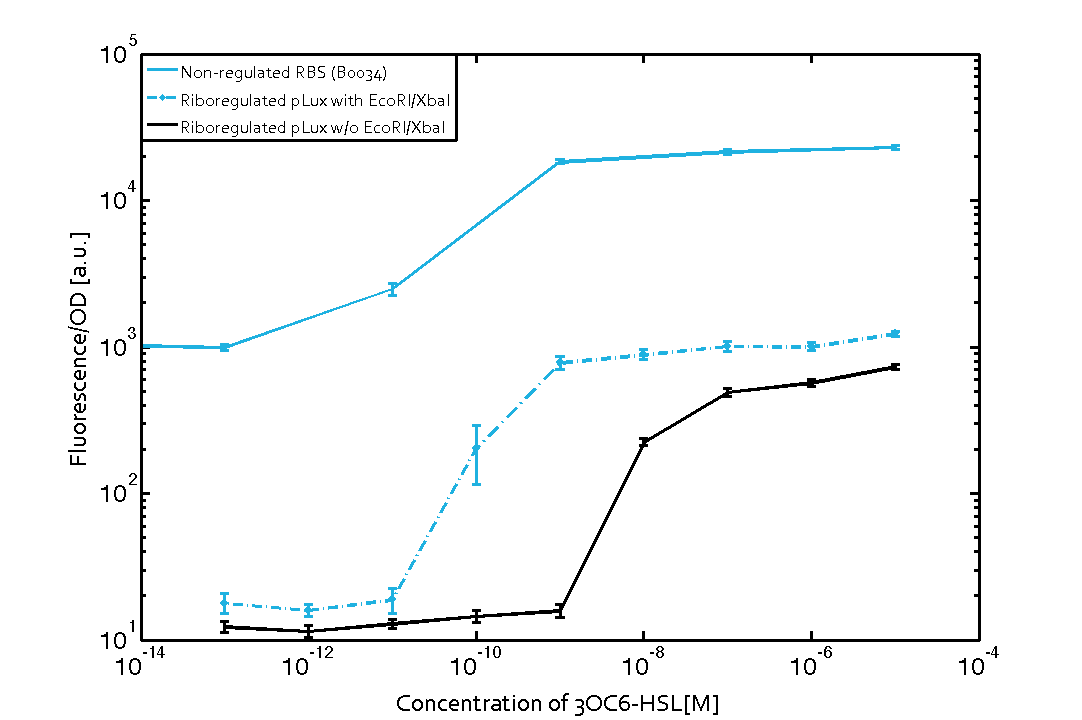Part:BBa_K1541009
sfGFP under promoter P(Rhl) with riboregulator RR12
This riboregulated promoter construct contains the quorum sensing promoter pRhl (BBa_I14017) which can be activated in presence of RhlR (BBa_C0171) and C4-HSL, the product of the enzyme RhlI (BBa_C0170), succeeded by the gene for superfolder green fluorecent protein (sfGFP). However, the promoter BBa_I14017 by itself shows leakiness. Together with the ribogegulator 12[http://www.pnas.org/content/109/15/5850.abstract|1] the leakiness could be reduced about 20-fold. This riboregulator consists of two parts, the cis-repressor blocking the ribosome binding site (RBS) by folding into an inaccessible secondary structure ('lock') and a trans-activator RNA opening this structure and making the RBS accessible ('key').
Usage and Biology

Expression of sfGFP is induced when RhlR (BBa_C0171), bound to C4-HSL, activates the promoter pRhl (BBa_I14017). The cis-repressor element (crR12, 'lock') inhibits the translation of sfGFP, since the RBS (BBa_B0034) is blocked by secondary structures of the folded mRNA. The transcript of the trans-activating element (taR12, 'key', also under the control of pRhl (BBa_I14017)) binds to the transcript of the cis-repressive element, changing the secondary structure and as a result the RBS is not blocked anymore (for details, see Sequences). The two elements build a riboregulator ('key' and 'lock') that decreases the leakiness of pRhl (BBa_I14017). The systems functionality is depicted in Figure 1.
Background Information



We used an E. coli TOP10 strain transformed with two medium copy plasmids (about 15 to 20 copies per plasmid and cell). The first plasmid contained the commonly used p15A origin of replication, a kanamycin resistance gene, and promoter pRhl (BBa_R0071) followed by a cis-repressed (crR12) version of RBS (BBa_B0034) and superfolder green fluorescent protein (sfGFP). The same plasmid contained the trans-activating RNA (taR12), also under control of the promoter pRhl (BBa_R0071). In general, for spacer and terminator sequences the parts BBa_B0040 and BBa_B0015 were used, respectively. The second plasmid contained the pBR322 origin (pMB1), which yields a stable two-plasmid system together with p15A, an ampicillin resistance gene, and the constitutive promoter BBa_J23100 chosen from the Anderson promoter collection followed by rhlR (BBa_C0171). The detailed regulator construct design and full sequences (piG0110) are [http://2014.igem.org/Team:ETH_Zurich/lab/sequences available here]. As controls, the non-regulated construct was included (see Figures 2 - 4), or only the cis-repressor used (Figure 3). In addition, the initially used riboregulator sequences[http://www.pnas.org/content/109/15/5850.abstract [1]] contained forbidden restriction sites (EcoRI and XbaI). The removal of the restriction sites achieved by blunting and ligation (Klenow and T4 DNA polymerase) had no significant influence on the result, as compared to the original riboregulator sequence, however the sensitivity was slightly reduced (see Figures 2 and 4). For Figures 2 and 3 the same construct with pLux (BBa_R0062) instead of pRhl (BBa_R0071) was used with RR12y[http://www.pnas.org/content/109/15/5850.abstract [1]]. Here the application of the riboregulator reduced the basal expression about 60-fold and the signal-to-noise ratio was increased about six-fold.
Experimental Set-Up
The above described E. coli TOP10 strains were grown overnight in Lysogeny Broth (LB) containing kanamycin (50 μg/mL) and ampicillin (200 μg/mL) to an OD600 of about 1.5 (37 °C, 220 rpm). As a reference, a preculture of the same strain lacking the sfGFP gene was included for each assay. The cultures were then diluted 1:40 in fresh LB containing the appropriate antibiotics and measured in triplicates in microtiter plate format on 96-well plates (200 μL culture volume) for 10 h at 37 °C with a Tecan infinite M200 PRO plate reader (optical density measured at 600 nm; fluorescence with an excitation wavelength of 488 nm and an emission wavelength of 530 nm). After 200 min we added the following concentrations of inducers (3OC6-HSL, 3OC12-HSL, and C4-HSL): 10-4 nM and 104 nM (from 100 mM stocks in DMSO). Attention: All the dilutions of 3OC12-HSL should be made in DMSO in order to avoid precipitation. In addition, in one triplicate only H2O was added as a control. From the the obtained kinetic data, we calculated mean values and plotted the dose-response-curves for 200 min past induction.
Sequences
trans-activator RNA (taR12) sequence: Sequence length = 75. 25 A's, 13 C's, 15 G's, 22 U/T's
5' ACCCAAAUCC AGGAGGUGAU UGGUAGUGGU GGUUAAUGAA AAUUAACUUA CUACUACCAU AUAUCUCUAG CUAGA 3'
cis-repressor RNA sequence (crR12, including the RBS in uppercase letters): Sequence length = 56. 18 A's, 9 C's, 12 G's, 17 U/T's
5' gaauuaauuc uaccauucac cucuuggauu uggguauuAA AGAGGAGAAA gguacc 3'
The predicted RNA structures are shown in Figure 5 and Figure 6 for the cis-repressed RNA (crR12) sequence and the trans-activator RNA (taR12) sequence ([http://mfold.rna.albany.edu/?q=mfold/RNA-Folding-Form mfold web server]), repectively. In a addition, a prediction of the hybridization of taR12 with crR12 including the accessible RBS is shown in Figure 7 ([http://mfold.rna.albany.edu/?q=DINAMelt DINAMelt web server]).

References
[http://www.pnas.org/content/109/15/5850.abstract [1]] Callura, J. M., Cantor, C. R., Collins, J. J., Genetic switchboard for synthetic biology applications, PNAS, 2012
| None |


